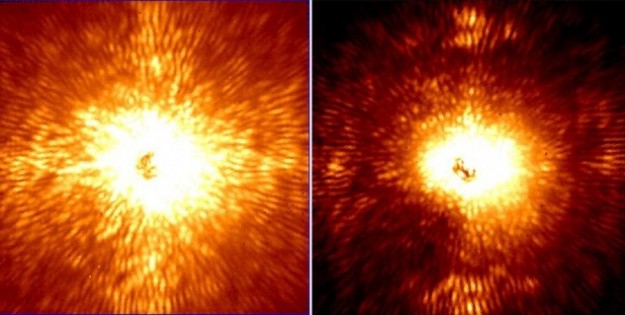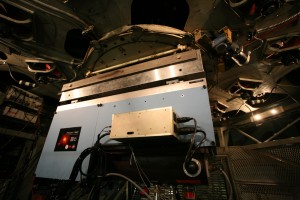
These two images show HD 157728, a nearby star 1.5 times larger than the sun. Its light has been mostly removed by Project 1640. The left image was made without the ultra-precise starlight control that Project 1640 is capable of, while the right image was made with the starlight control in place. (Images: Project 1640)
Astronomers have a powerful new tool to help them in their search for planets outside of our solar system.
Project 1640 is a first-of-its-kind, high-contrast imaging program which combines high-tech instrumentation and software, giving scientists the ability to spot planets orbiting distant suns in star systems outside of our solar system.
Ever since the search for exoplanets began, astronomers have relied on various indirect methods to detect them because the blinding brightness of their stars makes it virtually impossible to observe the planets directly.

The Project 1640 instrument mounted at the focus of the 200-inch Hale telescope. (Photo: © AMNH/B. R. Oppenheimer)
Project 1640 uses a new technique which produces extremely precise dark holes around stars of interest. This allows scientists a look at areas surrounding the star which would normally be obscured by its intense light.
“We are blinded by this starlight,” says Ben Oppenheimer, a principal investigator for Project 1640. “Once we can actually see these exoplanets, we can determine the colors they emit, the chemical compositions of their atmospheres, and even the physical characteristics of their surfaces. Ultimately, direct measurements, when conducted from space, can be used to better understand the origin of Earth and to look for signs of life in other worlds.”
Its creators say the system produces some of the highest-contrast images ever made, revealing objects that are one -to-10 million times fainter than the star at the center of the image.
The instrument, which started taking data last month, operates on the Hale Telescope at California’s Palomar Observatory. It’s been in development for more than six years through a collaborative effort among New York’s American Museum of Natural History, the California Institute of Technology (Caltech) and NASA’s Jet Propulsion Laboratory (JPL).
With Project 1640 up and running, researchers searching for extrasolar planets have begun a three-year survey to image hundreds of young stars outside of our solar system.
“The more we learn about them, the more we realize how vastly different planetary systems can be from our own,” says Gautam Vasisht, a Jet Propulsion Laboratory astronomer. “All indications point to a tremendous diversity of planetary systems, far beyond what was imagined just 10 years ago. We are on the verge of an incredibly rich new field.”





















Comments are closed.